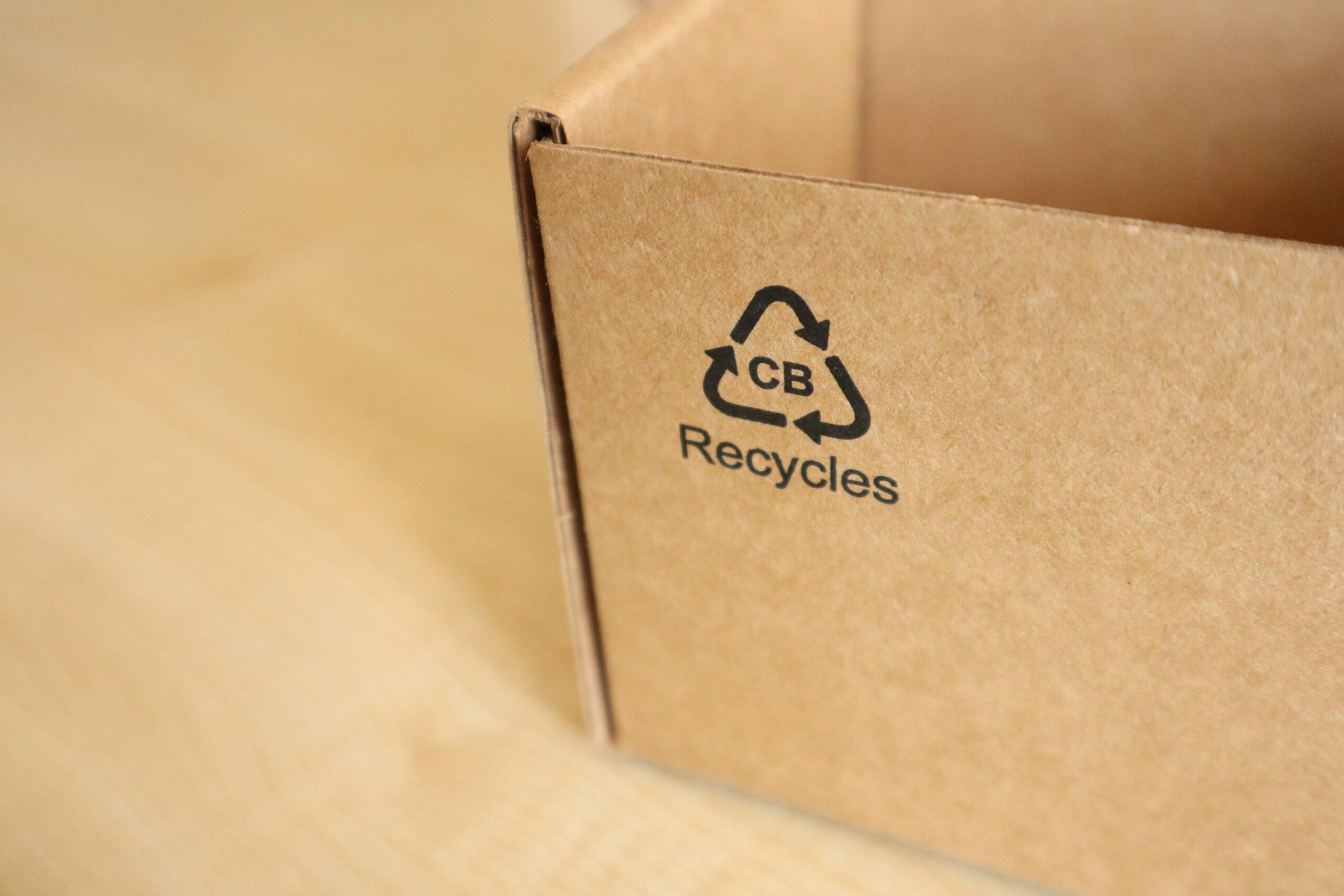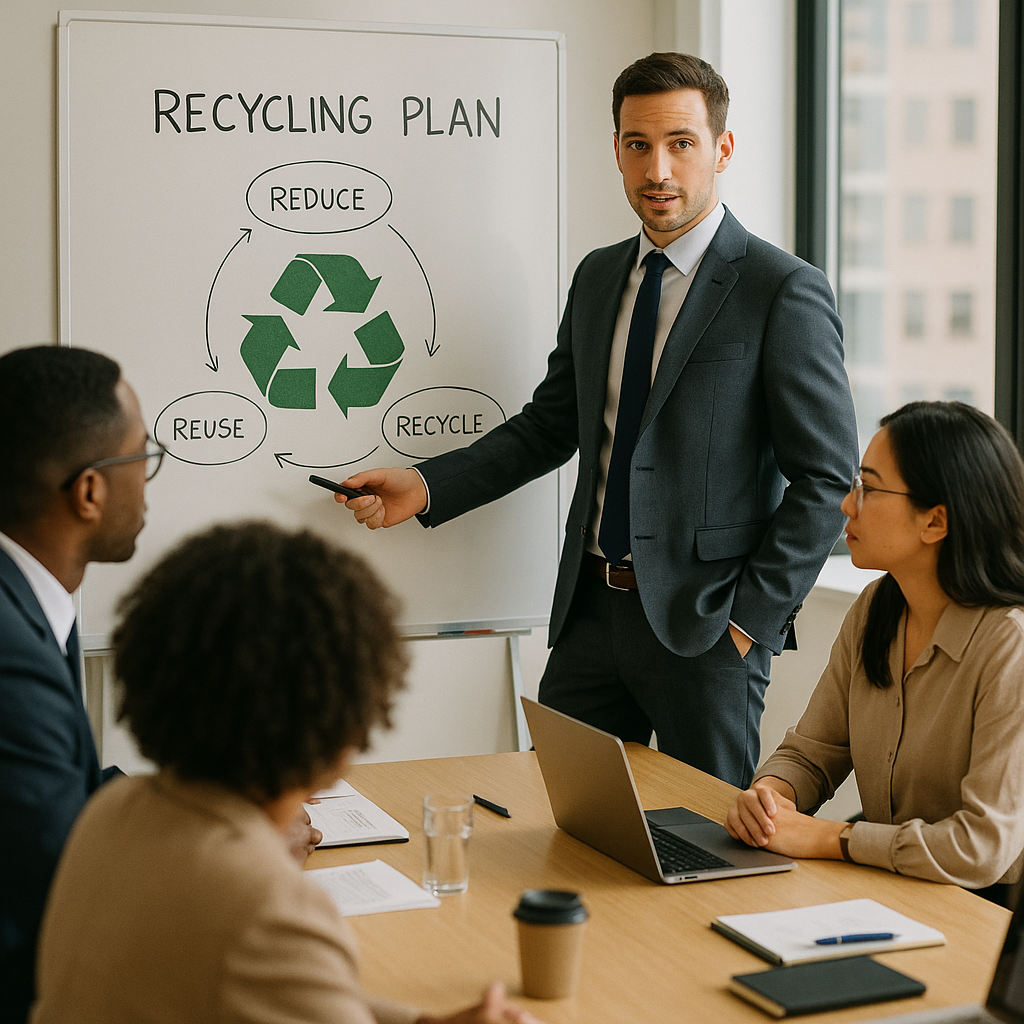5901 Botham Jean Blvd, Dallas, TX 75215
How to Start a Recycling Program at Work
July 18, 2025The average office worker generates about 2 pounds of paper waste every day. This staggering amount accounts for over 70% of office waste that could be recycled but often ends up in landfills. Starting a recycling program at work isn’t just an environmental gesture. It’s a strategic business decision that yields tangible benefits for both your company and the planet.
Workplace recycling programs do more than divert waste from landfills. They create significant cost savings through reduced disposal fees. Many companies report up to 30% lower waste management expenses after implementing comprehensive recycling initiatives. These programs also strengthen your organization’s environmental credentials, increasingly important in today’s eco-conscious marketplace.
Establishing an effective workplace recycling program requires thoughtful planning and company-wide commitment.
What Are the First Steps to Launch a Workplace Recycling Program?

Establishing a successful workplace recycling program requires strategic planning and employee engagement. The right approach will set your program up for long-term success while reducing your organization’s environmental footprint.
Secure Management Support
The foundation of any successful workplace recycling initiative begins with securing buy-in from upper management. Present the business case for recycling, highlighting potential cost savings from reduced waste disposal fees and the positive impact on company reputation.
When approaching leadership, come prepared with data on current waste disposal costs and projections of potential savings. Management support ensures you’ll have the necessary resources, time, and budget to implement an effective program.
Leadership involvement also signals to employees that sustainability is a company priority. When executives visibly participate in recycling efforts, it creates a culture of environmental responsibility throughout the organization.
Form a Dedicated Green Team
Assemble a group of environmentally passionate employees to champion your recycling program. This Green Team should include representatives from various departments to ensure diverse perspectives and company-wide adoption.
The team will serve as recycling ambassadors, answering questions, monitoring progress, and maintaining enthusiasm for the program. Schedule regular meetings to evaluate the program’s effectiveness and discuss potential improvements.
Creating a Green Team offers more than just practical support for your recycling program. It provides team-building opportunities and allows employees to develop leadership skills while contributing to an important cause.
Conduct a Comprehensive Waste Audit
Before implementing your recycling program, understand what types and quantities of waste your workplace generates. A waste audit involves examining the contents of trash bins over several weeks to identify recyclable materials that are currently being discarded.
During your audit, document the types of waste, their sources, and approximate volumes. Look for items that are present in significant quantities and are relatively free from contamination, as these make ideal candidates for recycling.
This data will help you determine which recycling streams to prioritize and where to place collection bins for maximum effectiveness. The waste audit results also provide a baseline against which you can measure your program’s success.
Research Local Recycling Regulations and Services
Recycling capabilities vary significantly by location. Contact your municipal recycling office or current waste hauler to learn exactly which materials can be recycled in your area and how they must be prepared.
Ask about specific requirements like whether paper must be separated from plastics or if certain types of plastic are excluded from collection. Understanding these guidelines prevents contamination, which can render entire batches of recyclables unusable.
When researching recycling services, compare costs and collection schedules from different providers. Your current waste hauler may offer recycling services at a reduced rate when bundled with your existing service.
Design Your Collection System
Create a recycling infrastructure that makes proper disposal convenient for employees. Place clearly labeled recycling containers in high-traffic areas and near points where recyclable waste is generated, such as printers, break rooms, and desks.
Always position recycling bins adjacent to trash cans to prevent recyclables from ending up in the garbage by default. Use consistent bin colors and signage throughout your facility to avoid confusion.
Develop a collection schedule and clearly define responsibilities for emptying bins. Determine whether this will be handled by custodial staff, the Green Team, or a combination of both.
Develop Clear Guidelines and Educational Materials
Create simple, visual guidelines showing exactly what can and cannot be recycled. Post these instructions prominently near all collection points and distribute them to all employees.
Include information about how to prepare items for recycling, such as emptying and rinsing containers or removing staples from papers. The clearer your instructions, the less contamination you’ll experience in your recycling stream.
Consider hosting kick-off training sessions to introduce the program and answer questions. These sessions can build excitement while ensuring everyone understands the proper procedures.
How Can You Educate and Motivate Employees to Participate?

Effective employee education forms the backbone of any successful office recycling program. Start with clear, informative signage placed directly at recycling stations. Use simple language and images to show exactly what can and cannot be recycled in each bin. This visual guidance eliminates confusion and reduces contamination issues.
Regular communication keeps recycling top of mind. Send monthly email updates with recycling tips and program achievements. Include these updates in company newsletters and team meetings to reinforce their importance. For new hires, incorporate recycling procedures into onboarding materials so proper waste disposal becomes standard practice from day one.
Training Sessions That Engage
Organize interactive orientation sessions that go beyond basic instructions. Consider arranging field trips to local recycling facilities where employees can witness firsthand what happens to their recyclables. These eye-opening experiences often transform abstract concepts into tangible realities that motivate action.
Train your janitorial staff thoroughly on proper materials separation. Their consistent handling of recyclables ensures the program’s integrity at every stage. Schedule regular refresher courses to address common questions and update everyone on any changes to recycling guidelines.
Incentives That Drive Participation
Competition can dramatically boost recycling rates. Implement department challenges with teams competing to achieve the highest recycling rates or lowest contamination levels. Track progress on visible leaderboards that foster friendly rivalry between departments.
Offer meaningful rewards for top performers. These might include gift cards, extra time off, or even small bonuses. Many companies find success with group incentives like office-wide celebrations when reaching major recycling milestones.
Making Recycling Fun and Engaging
Transform recycling into an enjoyable activity through gamification. Create recycling quizzes with prizes or organize themed events tied to environmental awareness months. An office mini-golf course built from recyclable materials can serve as both a team-building exercise and an educational opportunity.
Develop special challenges like Earth Day competitions where teams earn points for correct recycling practices, bringing litterless lunches, or answering environmental trivia questions. These activities make sustainability engaging even for employees who might otherwise be less enthusiastic.
Measuring and Sharing Progress
Regular feedback on recycling performance keeps motivation high. Share monthly statistics showing how much material was diverted from landfills. Translate these numbers into relatable terms like trees saved, energy conserved, or carbon emissions prevented.
Create visual dashboards displaying recycling metrics in high-traffic areas. Some organizations use digital displays near bin stations so employees can see the direct impact of their actions. When you reach significant milestones, celebrate these achievements company-wide to recognize collective efforts.
Establishing a Green Team
Form a dedicated sustainability team with representatives from different departments. This group can monitor recycling systems, address concerns, and implement new ideas. Their enthusiasm often spreads throughout the organization, creating recycling champions across all teams.
Empower this team to develop creative initiatives that keep recycling fresh and engaging. Their peer-to-peer influence typically proves more effective than top-down directives alone. Regular meetings allow them to evaluate program effectiveness and suggest improvements.
How Do You Maintain and Improve Your Recycling Program?
Successful recycling programs require ongoing maintenance and continuous improvement. Regular evaluation allows you to identify strengths, address weaknesses, and adapt to changing circumstances. This proactive approach ensures your program remains effective and continues to deliver environmental benefits.
Establish Regular Monitoring Systems
Data-driven assessment forms the foundation of any effective recycling program maintenance strategy. Request monthly tonnage reports from your recycling service provider detailing the quantities of materials collected. Track your recycling rate by comparing the weight of recyclables to your total waste generation.
Set specific recycling goals and monitor progress toward achieving them. This provides clear benchmarks to measure success and helps maintain momentum. Many companies find that establishing a baseline and tracking improvements over time creates accountability and helps justify program investments.
Visual inspections of collection bins can quickly reveal contamination issues. Check recycling containers periodically to assess whether employees are following proper sorting guidelines. High contamination levels signal the need for additional education or improved signage.
Gather Feedback from Stakeholders
Your employees interact with your recycling program daily and can provide valuable insights into its functionality. Conduct regular surveys to gauge their understanding of recycling procedures and gather suggestions for improvement. Their feedback can highlight practical issues that might not be apparent otherwise.
Schedule check-ins with your custodial staff, who often see firsthand what materials are being placed in recycling and trash containers. They can identify problem areas where contamination occurs frequently or where recyclables are being discarded as trash.
Maintain open communication with your recycling service provider. They can offer guidance on improving material quality and may suggest adjustments to your collection system. Their expertise can help you navigate changes in recycling markets and regulations.
Address Issues Promptly
When monitoring reveals problems, act quickly to implement solutions. If contamination levels rise, refresh signage on collection bins and provide additional training to employees. Clear visual guides showing acceptable items can significantly reduce sorting errors.
Adjust container placement if certain areas show poor recycling participation. Containers should be easily accessible and positioned where materials are generated. Sometimes simply moving a recycling bin to a more convenient location can dramatically improve usage.
Review your collection schedule if bins frequently overflow or if materials accumulate between pickups. Work with your service provider to optimize collection frequency based on the volume of recyclables your facility generates.
Implement Continuous Education
Recycling education should be an ongoing process, not a one-time event. Schedule periodic training sessions to reinforce proper recycling practices and address common mistakes. These sessions help maintain awareness and accommodate new employees who missed initial training.
Share program results with all stakeholders to maintain interest and motivation. Highlight successes, such as increased recycling rates or cost savings, in company newsletters or bulletin boards. Concrete achievements demonstrate the program’s value and encourage continued participation.
Consider designating recycling champions in different departments to promote best practices and answer questions. These individuals can help monitor compliance and provide peer-to-peer education, extending the reach of your recycling program.
Expand Your Program Strategically
Once your basic recycling program runs smoothly, look for opportunities to expand its scope. Survey your waste stream to identify additional recyclable materials that could be diverted from landfills. Common additions include batteries, electronics, or specialized plastics not accepted in general recycling.
Consider implementing composting for food waste and organic materials. Food waste represents a significant portion of commercial waste streams, and composting provides substantial environmental benefits. Start with a pilot program in one area, such as the cafeteria, before expanding company-wide.
Explore waste reduction initiatives that complement your recycling efforts. Strategies might include switching to reusable alternatives for disposable items, implementing double-sided printing, or working with suppliers to reduce packaging waste. These upstream approaches can significantly decrease the amount of material requiring management.
Leverage Technology and Reporting Tools
Many recycling service providers offer online portals or reporting systems that track your recycling metrics. These tools can generate detailed reports on material volumes, contamination rates, and diversion percentages. Use this data to identify trends and make informed decisions about program adjustments.
Consider implementing bin monitoring technology if your budget allows. Sensors can track fill levels and alert maintenance when containers need emptying. Some systems can even detect contamination issues, allowing for targeted educational interventions.
Document your recycling procedures and create a centralized resource where employees can access information. This might include an intranet page or physical binder containing accepted materials lists, container locations, and contact information for recycling coordinators.
By implementing these maintenance and improvement strategies, your recycling program can evolve from a basic waste management system into a comprehensive sustainability initiative that delivers increasing environmental and economic benefits over time.
Conclusion: Building a Sustainable Workplace Through Recycling

Implementing a successful workplace recycling program requires thoughtful planning, employee education, and ongoing commitment. When done right, these programs deliver significant benefits beyond just waste reduction. Businesses that prioritize recycling not only minimize their environmental footprint but often realize substantial cost savings through reduced waste disposal fees and more efficient resource use.
Perhaps most importantly, workplace recycling initiatives foster a culture of sustainability that resonates with employees. Staff members increasingly value employers who demonstrate environmental responsibility, leading to improved morale, enhanced recruitment potential, and stronger retention rates. By establishing clear recycling protocols, providing proper bins with intuitive signage, and regularly communicating progress, your company can make recycling a seamless part of daily operations. For expert guidance in developing or enhancing your workplace recycling program, contact Okon Recycling at 214-717-4083.
